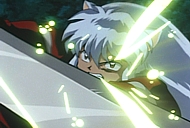
InuYasha Vol. 1
A long time back in the history of The Anime Review, I determined that I wasn't going to discuss any massively popular titles. There's no way you can win by reviewing a title like Dragonball Z or Sailor Moon. Some shows are simply critic-proof, and nothing I can say will change anybody's mind. Instead, I've always thought it would trigger a load of hate mail regardless of my position. There's also the problem of seeing enough of a series with over 100 episodes. How can you possibly summarize it? For a reviewer like myself that updates every week, there was no upside to it.
The one author who I've broken this rule for in the past is Rumiko Takahashi. The author of the mangas behind several long-running series I've enjoyed, including Maison Ikkoku and Urusei Yatsura, Takahashi's material can sometimes transcend the problems of length, staying fresh well beyond a couple of seasons worth of material. With that in mind, I decided I would finally sit down and watch the opening disc of InuYasha, which is easily her most popular title ever in the United States. Although I can't say I've seen much at all of the show, I can say that it is unique in the Takahashi canon, but not in a way that really drew me in. That said, I can see what's made it a small-scale juggernaut in the West and why fans might really enjoy it.
For those like me who don't already know the plot, InuYasha is a half-demon on the run from a feisty lass in feudal Japan named Kikyo. She shoots him with an arrow and seals him to a tree, but she dies soon afterwards. It seems that InuYasha will be bound forever...until Kagome appears. She's from the modern day, but by falling down a well near her family's home, she's sucked into the feudal era. She carries with her the sacred Jewel of Four Souls...but why? It was buried with Kikyo centuries ago. It appears that Kagome may be the reincarnation of Kikyo, but no one's certain. At any rate, all sorts of nasty folks (human, demon, and otherwise) are interested in the jewel since it bestows all sorts of nifty powers on its owner.
To make a long story short, in a battle with a centipede monster, Kagome awakens InuYasha from his sleep. He's quite the brute who wants the jewel for himself...but he's crafty enough to wait for the right time to get it. But he's not expecting Kagome to have power over him, which she does -- all she has to do is say a couple of words, and he's on his rump. Everything gets loads more complicated when the gem is blown into several dozen shards that appear to have spread all over Japan. Now Kagome and InuYasha have to form an uneasy alliance to get the parts of the jewel back together, something sure to take at least a season or two.
Most of Rumiko Takahashi's stories begin with a very simple plot explained within the first half of the first episode. Whether it's spazmo aliens or people turning into pandas or romantic hijinks in an apartment building, the setups are usually straightforward and give us a general expectation of what's to come. In comparison, InuYasha has a convoluted opening that takes nearly the entirety of the first disc's three episodes to lay out. Although the show isn't really any more complex than the others -- it looks strikingly like a standard "collect 'em all" journey setup not dissimilar to Pokemon -- the need for an hour's worth of material before we get to the heart of the plot is burdensome. We still know next to nothing about Kagome, who's almost the most generic character Takahashi's ever given us for a protagonist. When it comes down to it, despite his boorish attitude and half-demon nature, I was rooting for InuYasha for the sole reason that he livens up this first hour and a half considerably whenever he appears.
There were a few other things that caused me to be less interested in this show than Takahashi's other works. For one, if the opening episodes hold true to form, we're in for a "monster of the week." This if fine for 12-year-old boys, but it quickly loses interest for a 30-something like myself. The show also lacks a compelling backdrop. If there's any real complexity to the back-story, it's not given here. What the heck were they waiting for? It seems to me that they wanted to adapt the manga literally, and doing so meant an awfully boring start for those of us who didn't read the thing first. And if you have any concerns about mystical religious themes and Oriental legends about demons and monsters, just skip it. I haven't seen a show so spiked with these concepts in a long time.
Now that's not to say that there isn't a bit of promise here. For one, it's not hard on the eyes and ears; although it's lacking great production values, the animation quality is still fine, and the music isn't half bad. But there's more within the show itself that has potential. For one, it's subtly hinted that InuYasha had a bit of thing (however repressed) for Kikyo, and if Kagome is really her reincarnated self, there's going to be some interesting character tension and dynamics once things are explained. From hints at Adult Swim, I think this is the case, but we're going to be waiting an awfully long time to get there (somewhere around episode 147, I believe). Second, there's not the issue of the heroine being "stuck" in her new world. By the third episode, Kagome has made it back to present day Japan, something I never expected after watching bits of Escaflowne and Fushigi Yugi. If they were to play off that potential of going back and forth in time, now that would be something. The ads on Adult Swim haven't convinced me that it will actually be a major plot point, but it's not a plotline I've seen used much, and so potential is built into the formula. And the one thing that has almost always proven true with Takahashi is that her stories seem so plot-driven that you never notice how the characters sneak up on you and make you fall in love with them. InuYasha has enough swagger for a couple characters, and if the most is made of him, I can see the show truly developing.
The good and bad of a series like this is that, once you've seen the opening DVD, I think you'll be able to pick up most anywhere in the series. With 167 episodes and four feature films, there's plenty to see if you find it interesting. On its original release schedule with only three episodes on a disc, I would have been hard pressed to give it a recommendation; however, since season box sets are now available, it's possible for those willing to take the risk to jump in headlong and get past what is frankly a weak introduction to the series. The opening is the worst of any of Rumiko's series, in my opinion, but I'm willing to give it some grace based on its good side. Unlike Urusei Yatsura or Maison Ikkoku, I don't see myself compelled to see more right away, but it's decent enough that I might return to it at some point. Although it looks predictable on the surface, I would withhold further judgment until the series actually gets underway -- but be prepared that you're going to have to see a few discs if you expect to get hooked.
InuYasha Vol. 1 -- violence, Oriental occult demonology, fleeting nudity -- B

